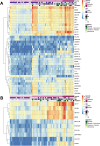Characterisation of the blood RNA host response underpinning severity in COVID-19 patients
- PMID: 35844004
- PMCID: PMC9288817
- DOI: 10.1038/s41598-022-15547-2
Characterisation of the blood RNA host response underpinning severity in COVID-19 patients
Abstract
Infection with SARS-CoV-2 has highly variable clinical manifestations, ranging from asymptomatic infection through to life-threatening disease. Host whole blood transcriptomics can offer unique insights into the biological processes underpinning infection and disease, as well as severity. We performed whole blood RNA Sequencing of individuals with varying degrees of COVID-19 severity. We used differential expression analysis and pathway enrichment analysis to explore how the blood transcriptome differs between individuals with mild, moderate, and severe COVID-19, performing pairwise comparisons between groups. Increasing COVID-19 severity was characterised by an abundance of inflammatory immune response genes and pathways, including many related to neutrophils and macrophages, in addition to an upregulation of immunoglobulin genes. In this study, for the first time, we show how immunomodulatory treatments commonly administered to COVID-19 patients greatly alter the transcriptome. Our insights into COVID-19 severity reveal the role of immune dysregulation in the progression to severe disease and highlight the need for further research exploring the interplay between SARS-CoV-2 and the inflammatory immune response.
© 2022. The Author(s).
Conflict of interest statement
The authors declare no competing interests.
Figures



References
Publication types
MeSH terms
Substances
Grants and funding
LinkOut - more resources
Full Text Sources
Medical
Miscellaneous

